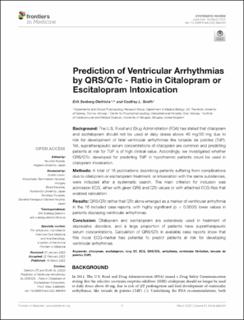| dc.description.abstract | Background: The U.S. Food and Drug Administration (FDA) has stated that citalopram and escitalopram should not be used at daily doses above 40 mg/20 mg due to risk for development of fatal ventricular arrhythmias like torsade de pointes (TdP). Yet, supratherapeutic serum concentrations of citalopram are common and predicting patients at risk for TdP is of high clinical value. Accordingly, we investigated whether QRS/QTc; developed for predicting TdP in hypothermic patients could be used in citalopram intoxication.
Methods: A total of 16 publications describing patients suffering from complications due to citalopram or escitalopram treatment, or intoxication with the same substances, were included after a systematic search. The main criterion for inclusion was admission ECG, either with given QRS and QTc values or with attached ECG-files that enabled calculation.
Results: QRS/QTc rather that QTc alone emerged as a marker of ventricular arrhythmia in the 16 included case reports, with highly significant (p < 0.0005) lower values in patients displaying ventricular arrhythmias.
Conclusion: Citalopram and escitalopram are extensively used in treatment of depressive disorders, and a large proportion of patients have supratherapeutic serum concentrations. Calculation of QRS/QTc in available case reports show that this novel ECG-marker has potential to predict patients at risk for developing ventricular arrhythmias. | en_US |

